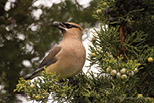Return to 3rd Quarter 2019 articles.



For plants to grow, there must be soil, moisture, and the planting of the seeds. Many places have moisture and soil that could support plant life, but how do you get the seeds to that area? The solution is God's horticulture system.
Around the interstate highway system in our area (southern lower Michigan), we see the growth of red cedars (Juniperus virginiana). These desirable trees are slow growing and can become valuable timber. The state does not plant trees, and yet many red cedars are growing along our highways.
The animals planting those evergreens are birds. The cedars provide valuable habitats for the birds, and the birds plant the trees. Cedars produce blue berries that the birds eat. If you put one in your mouth, you would cringe at its bitter taste and obnoxious consistency. Birds eat them with zest and in large quantities. Birds get nutrition from the berries, and their digestive systems are specifically designed to process the seeds for growth. The birds drop the seeds along with natural fertilizer in barren places. Birds and trees benefit from this symbiosis in God's horticulture system.
Other important seeders are squirrels. They are designed to bury seeds such as acorns, but their brain limitation causes them to forget a percentage of the seeds they bury. The design of fruits and nuts provide nutrition for animal life while the animals provide a means for the plants to grow in places far from their ancestors.
When scientists look at the diet of dinosaurs by examining their petrified excrement, they find that dinos were the seeders of their day. The plant-eating dinosaurs spread the seeds of the plants they ate along with nutrients that allowed fantastic jungles to form. The meat-eating dinosaurs kept the population of plant eaters under control so they would not eat all of the plants.
When we look at all the different kinds of seeds, the nutrients they contain, and where they can grow, we see a plan and design. Humans are still learning how to copy God's horticulture system to feed our growing population.
Picture credits:
Paul Sparks © 123RF.com
